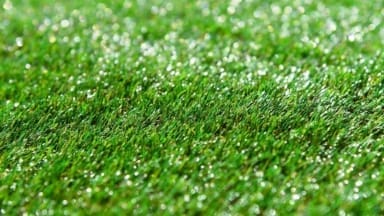
Made of synthetic fibres to look like natural grass, artificial turf, once commonly used in sports arenas is now being used far more regularly for residential lawns.
The environmental damage of the use of artificial grass is substantial. The 2023 Say No to Plastic Grass & Plants campaign by the Society of Garden + Landscape Designers, revealed that plastic grass not only removes vital habitat and is devoid of any value for wildlife, but also causes plastic pollution, leakage of micro-plastics into waterways, flooding, contribute to urban heat islands due and contribute to greenhouse gas emissions in their production.
Artificial grass also fails to provide any food for living creatures, restricts access to the soil beneath for burrowing insects and to the ground above for soil dwellers such as worms. It restricts access to natural materials such as leaf litter, essential for feeding soil organisms like worms and microscopic animals, that keep the soil healthy. In hot weather, artificial grass reaches significantly greater temperatures than those reached by natural grass under the same weather conditions – contributing to global warming by absorbing significantly more radiation than living grass and, to a lesser extent, by displacing living plants that could remove carbon dioxide through photosynthesis.
“Inevitably, if you are putting what is ostensibly a plastic film across the soil, you are reducing the amount of rainfall entering the soil, so it’s going to dry out. Artificial lawns also negatively affect soil health as they limit the supply of both air and water to the soil beneath them, which impacts the tiny organisms that live in the soil as a result,” explained Dr Mick Hanley, Associate Professor in Plant-Animal Interactions (Goodhouse Keeping, April 2024).
Research conducted by the tradespeople platform, mybuilder.com revealed that more than a third of the respondents want a ban on artificial grass – a 50% increase from just a year ago. In 2024, 24% of people would support a ban, which in 2025 stands at 36%. According to the platform, this would explain the drop in popularity for the product, as enquiries (my builder.com) for artificial grass installation were down 48% year on year, in 2023.
According to mybuilder.com, support for a ban is universal across age groups and gender. Geographically, there was some variation, with the strongest support for a ban amongst residents in Edinburgh (53%) and Manchester being the least supportive – although 32% still stated they would like to see a ban on the product.
In response, Stefan Diderich, the Director General at the EMEA Synthetic Turf Council said: “The use of synthetic turf in domestic landscaping is perhaps the most misunderstood of all its applications. It is important to recognise that synthetic turf by and large exists as an alternative to hard landscaping, rather than natural grass, and is installed when it is not feasible or practical for natural grass to be present.v For instance, for those of limited mobility and means to maintain natural grass, such as the elderly, synthetic turf allows green spaces to exist where the alternative might otherwise be concrete or stone. For younger generations, synthetic turf can also help to facilitate active lifestyles through play on a surface which is generally much safer than tarmac or concrete. In this respect, synthetic turf is an essential asset to many homeowners, and a ban on this product category in the UK is likely to cause more harm than good.”

